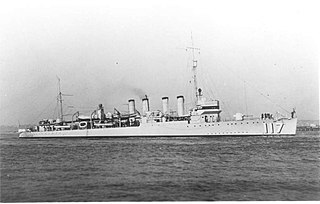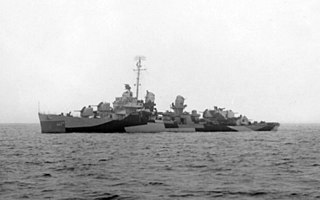
USS Chandler (DD-206/DMS-9/AG-108) was a Clemson-class destroyer in the United States Navy. She was the only ship named for William Eaton Chandler, who served as Secretary of the Navy from 1882 to 1886.

USS Mertz (DD-691) was a Fletcher-class destroyer in the service of the United States Navy from 1943 to 1946. She was scrapped in 1972.

USS John C. Butler (DE-339) was the lead ship of her class of destroyer escorts in the service with the United States Navy from 1944 to 1946. She was recommissioned between 1950 and 1957 and finally sunk as a target in 1971.

USS Dorsey (DD–117), reclassified DMS-1 on 19 November 1940, was a Wickes-class destroyer in the United States Navy during World War I. She was named for John Dorsey.

USS Howorth (DD-592) was a Fletcher-class destroyer built for the United States Navy during World War II.

USS Halligan (DD-584) was a Fletcher-class destroyer of the United States Navy, named for Rear Admiral John Halligan, Jr. (1876–1934).

USS Overton (DD-239/APD–23) was a United States Navy Clemson-class destroyer and high-speed transport that saw service during World War II.

USS Paul Hamilton (DD-590), a Fletcher-class destroyer, was the second ship of the United States Navy to be named for Navy Secretary Paul Hamilton (1762–1819).

USS Melvin (DD-680), a Fletcher-class destroyer and the second ship of the United States Navy to be named for Lieutenant, junior grade John T. Melvin (1887–1917), who was killed on 5 November 1917 while serving on the USS Alcedo in World War I and is recognized as the first American naval officer to die in that war.

USS Hall (DD-583) was a Fletcher-class destroyer of the United States Navy. Hall entered service in 1943 and deployed to the Pacific theater. Following the war, the ship was placed in reserve until 1959, when she was sold to the Hellenic Navy and renamed Lonchi. The destroyer remained in service with the Hellenic Navy until 1990 and was scrapped in 1997.

USS Heywood L. Edwards (DD-663) was a Fletcher-class destroyer of the United States Navy, named after Lieutenant Commander Heywood L. Edwards (1905–1941), captain of the destroyer USS Reuben James, the first U.S. Navy ship sunk in World War II. Following the war, the ship was transferred to Japan and renamed Ariake. The ship served with the Japanese until 1974 and was scrapped in 1976.

USS Cotten (DD-669) was a Fletcher-class destroyer of the United States Navy, named for Captain Lyman A. Cotten (1874–1926).

USS Darby (DE-218) was a Buckley-class destroyer escort in service with the United States Navy from 1943 to 1947 and from 1950 to 1968. She was sunk as a target in 1970.

USS Raymond (DE-341) was a John C. Butler-class destroyer escort acquired by the U.S. Navy during World War II. The purpose of the destroyer escort was primarily to escort and protect ships in convoy, in addition to other tasks as assigned, such as patrol or radar picket. Post-war, she returned home with five battle stars to her credit, including credit for her striking a Japanese cruiser with her 5-inch (127 mm) guns during the Battle off Samar. The destroyer escort was named for Reginald Marbury Raymond, who was killed by enemy gunfire on 30 April 1943 aboard USS Scorpion.

USS Richard S. Bull (DE-402) was a John C. Butler-class destroyer escort in service with the United States Navy from 1944 to 1946. She was finally sunk as a target in 1969.

USS Richard M. Rowell (DE-403) was a John C. Butler-class destroyer escort acquired by the United States Navy during World War II. The primary purpose of the destroyer escort was to escort and protect ships in convoy, in addition to other tasks as assigned, such as patrol or radar picket. During her career she earned six battle stars to her credit.

USS Edmonds (DE-406) was a John C. Butler-class destroyer escort in service with the United States Navy from 1944 to 1946 and from 1951 to 1965. She was scrapped in 1973.

USS Howard F. Clark (DE-533) was a John C. Butler-class destroyer escort in service with the United States Navy from 1944 to 1946. She was sold for scrapping in 1973.

USS Feland (APA-11) was a Doyen-class attack transport in service with the United States Navy from 1943 to 1946. She was scrapped in 1964.

USS Loeser was a Buckley-class destroyer escort of the United States Navy, named in honor of Lieutenant Commander Arthur E. Loeser (1903–1942).




















